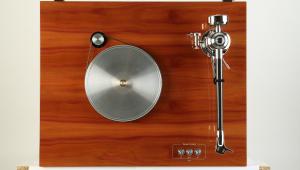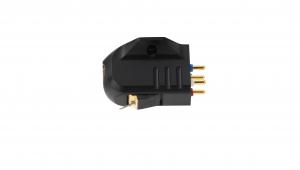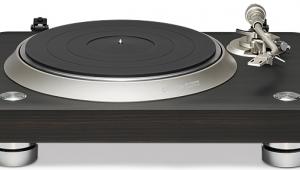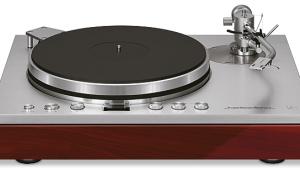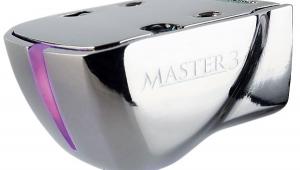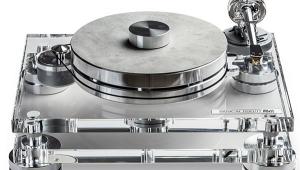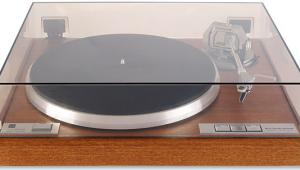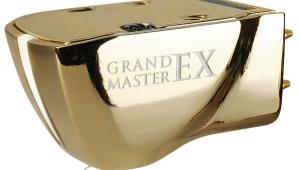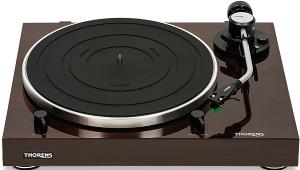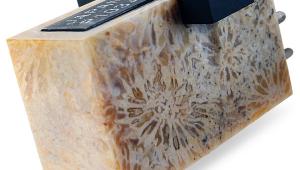Rega P9 Turntable Package (£4994)
Actually, there is nothing new about the turntable, or indeed the arm reviewed here. What is new, and rather exciting, is the completion of the P9 package with Rega’s long-awaited Apheta MC cartridge and the just-released Ios moving-coil phono stage. On paper, this is the best the company has to offer.
A key feature of the P9 is the ceramic platter, as hard as ruby or sapphire, which first appeared on the preceding Planar 9 in 1997. ‘Adding engineering philosophy to listening experience,’ says Rega’s founder and owner Roy Gandy, ‘I find that the harder and stiffer the platter material, the less character it puts into the music. This is a big step up from glass.’
PLATTER AND POWER
Relatively thin across the centre, but with more mass at the rim, the P9 platter is the optimum form, but is very expensive to make as it has to be diamond-machined all over after firing. Incidentally, the P7 platter, also ceramic, looks more elaborate but is much less costly to make. Here a flat ceramic disc is lapped to a finish, and peripheral weights accurately glued in place, before firing. Rega believes the motor should be rigidly mounted and thus fixed in position relative to the platter, and to make this possible, the motor must produce as little vibration as possible.
‘Most people design a power supply to simulate the mains,’ says Gandy. ‘We’ve approached it with a view to reducing motor vibration, and in fact we’ve reduced it by about 100 times.’
A synchronous motor runs at a speed determined by the frequency of the alternating current supply, 50Hz in the case of the UK mains. Before it can rotate, the motor also needs a second AC source, out of phase with the first. Conventionally, a simple connection via a capacitor provides roughly what is needed, but the motor can be made to run much more smoothly by improving the power supply. Rega’s ultimate solution is the mains-regenerator power supply of the P9, which incidentally provides 33.3 and 45rpm speeds. This unit synthesises the two motor-driving AC phases separately, and the lag or angle between them is adjustable, as are their voltages. So there are three adjustments for each speed, and each power supply unit is individually tuned to the motor of its turntable. Touch the motor while it is running and you will find that vibration is almost undetectable.
Introduced in 2002, the RB1000 is the top model in Rega’s arm line, the most highly-developed derivative of the original RB300. The famous silicon-aluminium arm tube casting is highly polished, with no paint or coating of any kind. Bearings are selected and assembled to the highest standard, while other parts use better materials than in Rega’s lower-cost arms – the mounting block in stainless steel, for example. Arm wiring is in one continuous run from cartridge tags to phono plugs.
ENTER THE APHETA
When Rega started to come up with more expensive turntables, its overseas distributors asked for a cartridge to match them. ‘We’d pushed our moving-magnetic cartridge range to its limit with the Exact,’ says Gandy. ‘So we were sort of urged into the moving-coil direction by our distributors.’
Essentially, the Apheta was designed to eliminate the usual tie-wire, which positions the moving-coil assembly, and has to be critically tensioned and damped. To do this, Rega adopted a structure similar to its moving-magnet designs. Apheta cartridges are hand-built alongside the moving-magnet models, but in much smaller numbers of course.
Having spent four years developing a moving-coil cartridge, Rega had gained some pretty firm ideas about phono stages. So now we have the Ios, which combines a 1:10 transformer with further stages of amplification [see inside shot, overleaf]. It is adjustable to suit most moving-coils (not moving-magnets), with more controls than you might expect. There’s a five-position loading switch (50, 100, 150, 300 and 400ohm) plus a second five-way switch to be set according to the cartridge’s DC resistance, in a nominal range of 6.25ohm to 15ohm, the latter suiting the Apheta. There is a also two-position gain switch (64dB and 70dB).
Finally, and most unusually, there is an adjustable filter, ‘designed to enhance the Apheta cartridge by reducing unwanted high frequency energy present.’ It is described as a notch filter centred on 8.5kHz, adjustable from 0 to –6.5dB and said to be useful for older pressings with higher surface noise.
REGA'S OWN RECORDING
Listening just had to start with Rega’s own Christine Collister recording, Love [ENS 002], which sounded crisp and fresh throughout. There was a fine clarity and immediacy to the atmospheric wind effects and delicate cloud of background vocals as Collister navigated the airy lyrics and never-landing melody of Joni Mitchell’s ‘Amelia’. Well, I told a lie.
Actually, the very first record to go on to the P9’s felt mat was a 40-year-old cheap-label LP of Lester Young, recorded live at a club in 1948, Prez [Summit AJS 2]. This recording, terrible in so many ways, contains great performances and the Rega just allowed you to imagine yourself right into that long-vanished nightspot. With a bandwidth restricted to that of AM radio, it didn’t need the filter, surface noise or not.
Although recorded back in 1960, my copy of The Greatest Trumpet Of Them All by the Dizzy Gillespie Octet [on HMV CLP 1381] is another mono treasure, but by contrast a clean and dry studio recording. The Rega was especially attractive on the gorgeous, furry sound of Benny Golson’s tenor sax and seemed to dig out the nuances of Gillespie’s trumpet, with lifelike dynamics.
This led me on to another great trumpeter, in that all-time audiophile classic The King James Version [Sheffield LAB-3]. On the opener, ‘Corner Pocket’, the leader’s solo was reproduced with all the spiky attack of a real trumpet, yet with absolute confidence and no sense of strain whatsoever.
Containing the epochal ‘I Shot The Sheriff’, Eric Clapton’s 461 Ocean Boulevard [RSO 2479 118] is also notable for his slide playing, especially on the opening track ‘Motherless Children’. With the Rega P9, this compressed, processed, even muffled track could burst out from the loudspeakers in all its fuzzy glory, the overdriven guitars really sizzling, the whole thing alive with great energy. If you get bored during ‘Willie and the Hand jive’, you can just enjoy listening to the controlled power of Carl Radle’s bass. At least, you can on this P9 package.
Turning to a more civilized kind of recording, Rob Wasserman’s Duets [MCA 42131], and the inevitable ‘Ballad Of The Runaway Horse’, I’d always felt that Wasserman’s great strength as accompanist on this track was his perfect, solid sense of time. Now, though, I could really sense his close rapport with Jennifer Warnes, feeling a subtle lilt in the rhythm as the two of them shaped each phrase.
Meanwhile, Joan Baez [Pure Pleasure/Vanguard VSD2077] was just riveting. There was great realism in the accompanying guitars, the true sound of strings being plucked, but never falsely distracting. No-one could be unmoved by Joan’s soaring voice on ’10,000 miles’, or ‘The House Of The Rising Sun’, even if it did take on a touch of hardness.
A different kind of ‘Lovely Joan’ appears as the counter-theme in Vaughan Williams’ Fantasia On Greensleeves [with Barbirolli, EMI ASD 521], the strings and even the ambience of the hall itself seemed drenched in a woody quality, the acoustic huge and deep. After all this, I’d come to the conclusion that I didn’t often want to use the filter. However, it was arguably an improvement on the old 1967 favourite Barenboim/ECO Mozart K467 [EMI ASD 2465], taming the strings a little, and it could help some bright-sounding 1950s/1960s American recordings.
PRACTICALITIES
In practical terms, the P9 seems luxurious by comparison with other Rega turntables, perhaps just because the arm and platter look so good. The good-quality lid will stay open, if a little precariously, in the vertical position. You wouldn’t expect this company to provide friction hinges, would you? The sonic penalty for using the lid is relatively small, but it does rob the sound of the last ounce of delicacy and dynamic rightness. Fortunately, it is easy to fit and remove.
As usual, Rega recommends leaving the motor running during a record-playing session, which is a good thing as it’s also recommended that you place the power supply (and hence the on/off switch) as far away from the turntable as its connecting lead allows. Having only listened to this player system as a whole, I still feel driven to suspect that there are other moving coil cartridges that might perhaps yield more ‘air’, perhaps more transparency, perhaps other comfortingly euphonic qualities.
Yet this player system as it stands is a tour de force. It often kept me listening right through albums where I’d only intended to sample a track. When I put on Stevie Ray Vaughan’s Tin Pan Alley [from Pure Pleasure’s Texas Flood double, PPAN 38734], I was still trying to make notes, right up to the line ‘I heard a woman scream’, where the guitar screams too. Then I gave up. All I can say is, it sounded great.
VERDICT
There may be other design approaches and other flavours when it comes to record replay, but Rega’s top player combination really delivers a sound that makes you want to go on listening, and allows you to find your way further into the music. It responds to care in placement, and it sounds better with the lid off, but when all’s said and done, it is spectacularly good value.
Originally published in the August 2009 issue






